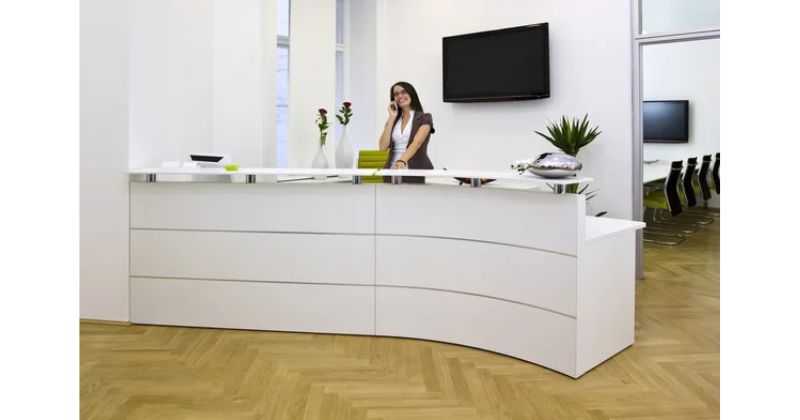Choosing the right reception table for your space is a pivotal decision that can influence both the functionality and aesthetics of your entryway or lobby. When selecting the right reception table design for office it’s essential to balance aesthetics with functionality to create a welcoming and efficient space. Start by considering the dimensions of your reception area to ensure the table fits well without crowding the space. This piece of furniture sets the tone for the first impression guests will have so it’s important to consider several factors to ensure it complements your space and serves its purpose effectively. Here’s a comprehensive guide to help you select the ideal reception table for your needs.
1. Understand Your Space
Dimensions and Layout: Start by measuring the dimensions of your space. Consider both the length and width of the area where the reception table will be placed. It’s crucial to ensure that the table fits comfortably without obstructing pathways or making the space feel cramped. Take note of the room’s layout including doorways seating arrangements and any architectural features that might affect the table’s placement.
Style and Functionality: Think about the style of your space. Is it modern traditional industrial or eclectic? Your reception table should harmonize with the overall design aesthetic. Additionally consider the table’s functionality. Will it primarily serve as a check-in desk a display area or both? This will influence the table’s design and features.
2. Choose the Right Shape and Size
Shape: Reception tables come in various shapes including rectangular round and square. The shape you choose should complement the layout of your space. Rectangular tables can be leaned up against a wall and are ideal for small areas. Round tables are ideal for smaller areas as they facilitate smooth traffic flow and create a welcoming ambiance. Square tables can work well in symmetrical spaces but might be less practical in tight areas.
Size: The size of the table should be proportionate to the space. A table that is too large can overwhelm the room while a table that is too small can appear insignificant. Ensure that the table provides ample surface area for its intended use whether it’s for greeting guests displaying brochures or holding a decorative centerpiece.
3. Material and Finish
Material: Reception tables are available in various materials each offering different aesthetics and durability. Wood is a classic choice that adds warmth and sophistication but requires maintenance. Metal tables offer a sleek modern look and are highly durable. Glass tables can make a space appear larger and more open but they may require more frequent cleaning to maintain their clarity.
Finish: Consider the finish of the material. A matte surface might be more appropriate for a more somber design yet a high gloss finish can provide a more modern appearance. If opting for wood think about whether you want a natural stained or painted finish and how it will match with other furnishings and decor elements.
4. Incorporate Functionality
Storage and Features: Evaluate whether you need additional storage or features in your reception table. Some tables come with built-in drawers shelves or cabinets which can be useful for storing office supplies documents or personal items. Features like integrated lighting or power outlets might also be beneficial depending on the needs of your space.
Accessibility: Ensure the table height is appropriate for its intended use. The standard height for reception tables is usually around 30 inches but this can vary depending on whether the table will be used by standing or seated guests. Make sure that the table is easily accessible and that it allows for comfortable interaction with visitors.
5. Style and Design
Aesthetic Harmony: Select a table that fits seamlessly with the existing decor. Think of components like color texture and design. For a modern space you might choose a sleek minimalist table with clean lines. In a more traditional setting a carved wooden table with intricate details might be more appropriate. The design of the table should reflect the overall theme and mood of your space.
Personal Touch: Don’t forget to add a personal touch to the reception table. This could be in the form of a stylish centerpiece decorative accents or branded items that reinforce your identity. The table can also serve as a platform for showcasing art or floral arrangements that enhance the welcoming atmosphere.
6. Budget Considerations
Cost vs. Quality: Finally balance your budget with the quality of the table. While it’s important to find a table that fits your budget it’s equally crucial to invest in a piece that is well-made and durable. Sometimes spending a bit more upfront can save money in the long run by avoiding frequent replacements or repairs.
Additional Costs: Consider any additional costs associated with the table such as delivery assembly or maintenance. Make sure to factor these into your budget to get a clear understanding of the total expenditure.
Conclusion
Choosing the right reception table involves a thoughtful consideration of space style functionality and budget. By understanding your space selecting the appropriate shape and size and incorporating the right materials and features you can find a reception table that not only enhances the aesthetics of your space but also meets practical needs. A well-chosen reception table will provide a welcoming and functional focal point that leaves a lasting impression on visitors.
For more insightful articles related to this topic, feel free to visit- ( Click Here )




